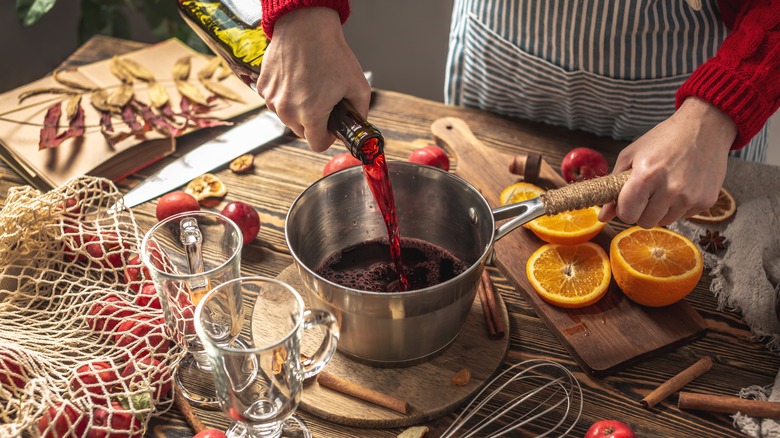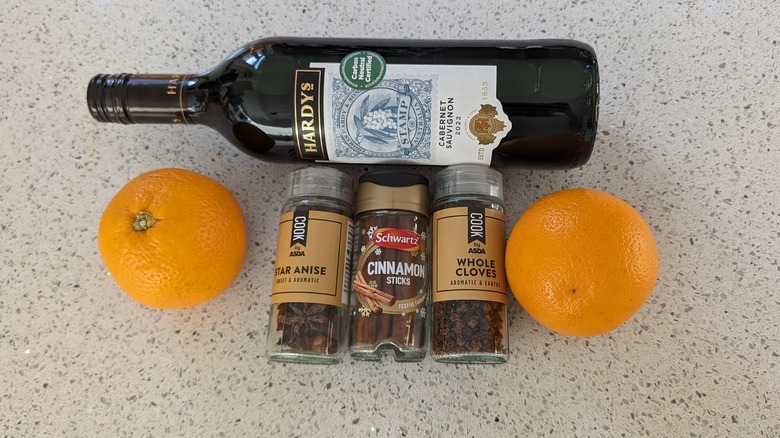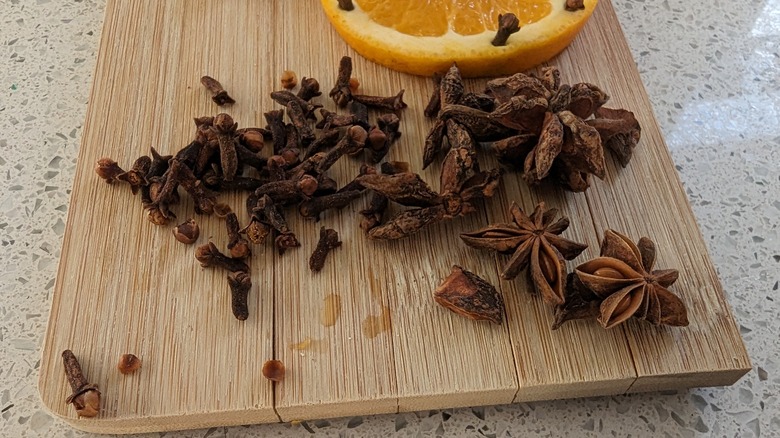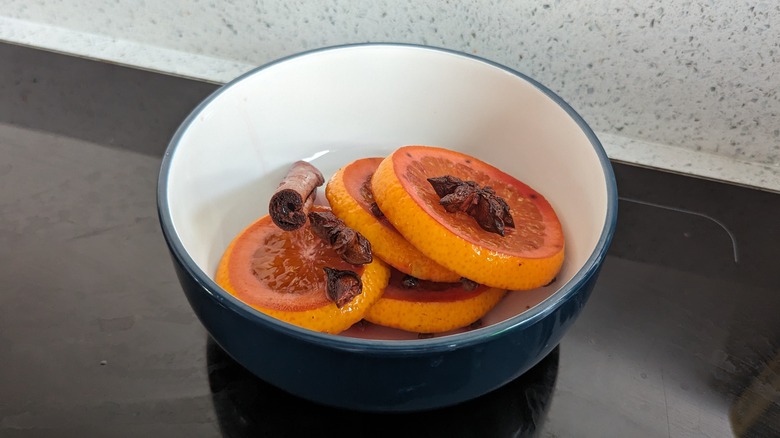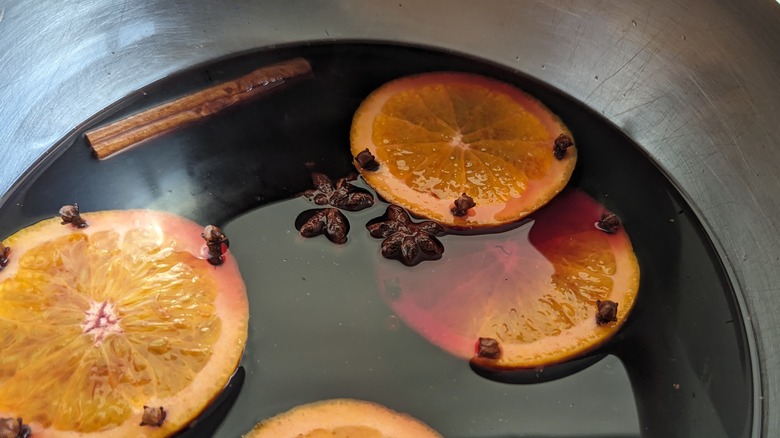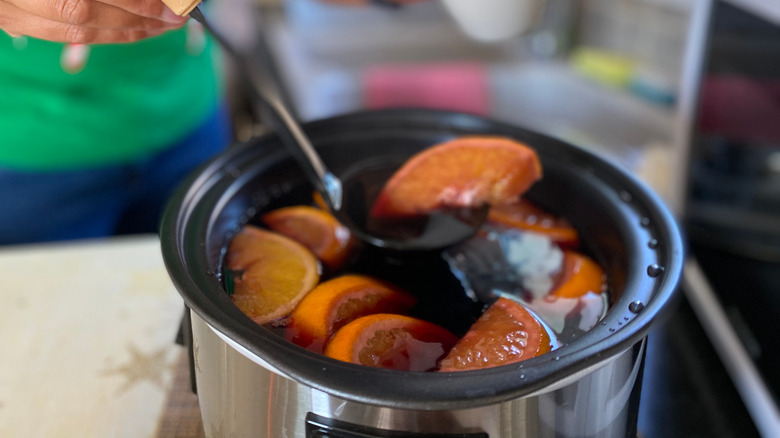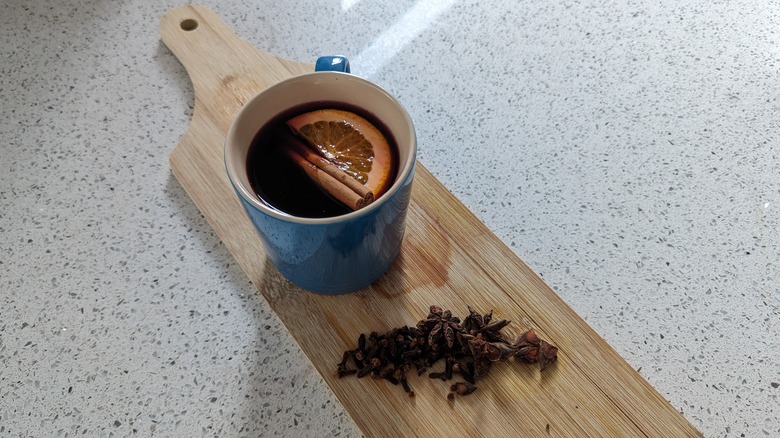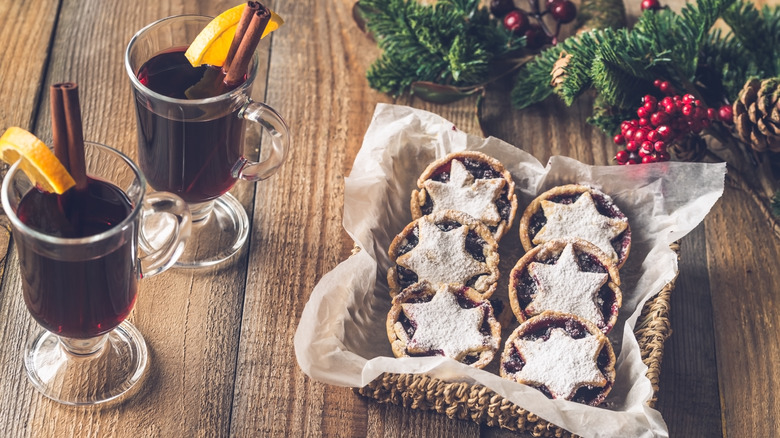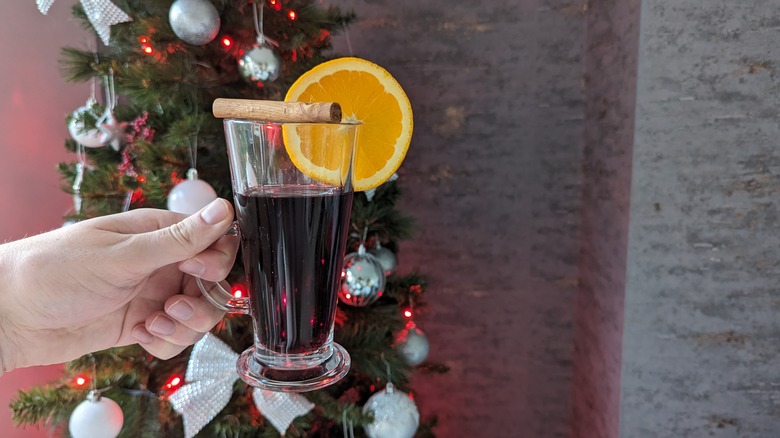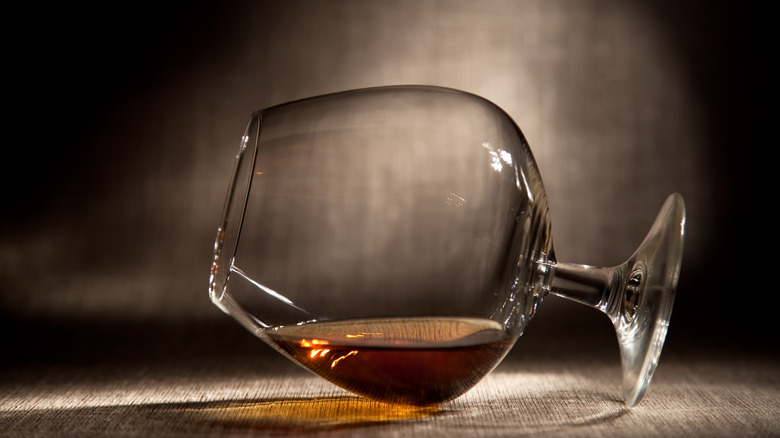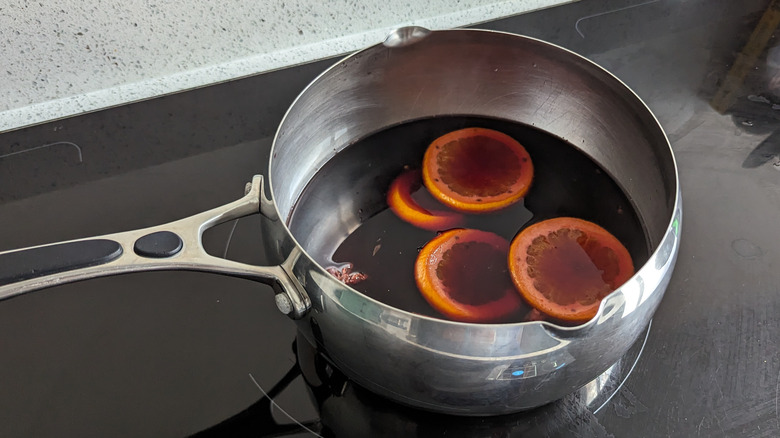10 Tips To Serve And Drink Mulled Wine This Winter
Mulled wine has a long and storied history, with most European nations having their own version of this hot, spiced, fruity drink. The British have mulled wine, the French have vin chaud, the Germans have glühwein, and the Greeks have krasomelo.
You put a spice blend in a wine of your choice, heat it up, and serve it to chilly guests during the winter months. However, if you want your warm treat to go down well, there are a few things you should consider in addition to the ingredients. Your preparation and serving methods need to be on point, the vessels you're filling should be considered, and you'll definitely need a snack on the side. What good is mulled wine if it isn't washing down something tasty?
To save you some stress at this busy time of year, we've compiled a list of 10 tips that should ensure your mulled wine is a hit this year, and for many years to come. This list is based on our own extensive experience of making, serving, and enjoying mulled wine. We've spent many years making our own mulled wine, sampling friends' efforts, and paying too much for a hot glass at cold Christmas markets. This has given us a good idea of what works (and what doesn't) when making and serving this winter staple. So sit back, pour yourself a glass of something warm, and enjoy our tips to serve and drink mulled wine this winter.
Create your own recipe — and experiment with it
While it's not too difficult to find a classic mulled wine recipe online, such recipes should be seen as more of a starting point than a set way to create this seasonal favorite. You may see the drink as only a moderately priced, full-bodied red wine that's been heated up with some spices, but mulled wine can actually be a pretty diverse beverage.
As for the base, there are many different types of wines to use for mulled wine. Sticking with reds, it's possible to go with a light-to-medium-bodied red instead of something fuller, and you should adjust the spices you use accordingly. It may be a good idea to go heavier on the cardamom with a lighter red, while leaning more towards spices like nutmeg with a fuller base. White wine can also be mulled, if you want something a little unique.
Whatever your choice, you should tweak your recipe to match your personal taste, and the tastes of your guests. The only real way to do this is by trial and error, so keep notes and either refine the recipe over several winters or stock up for some intense testing. If you know your spices, you'll know what should be added or reduced to create a drink that matches your tastes. You should also test a few different base wines, as they are all different and your choice of bottle will have a major impact on the final result. The recipe you eventually create will be something truly special. You can keep it a secret, pass it on through the family, or tell everyone about it. Either way, it's worth the effort.
Use whole spices
If your mulling session is a spontaneous idea, you may be tempted to simply use what you have in the house. Plenty of homes have a bottle of red which has been taking up counter space for a good while, along with every spice you could possibly need on a shelf. But you should still take a trip to the grocery store if you don't have whole spices available.
Whole cloves, cinnamon, and star anise are especially important to a good mulled wine. The ground versions of the spices will absorb into the wine differently, so whatever recipe you're using may be off. Ground spices can also lose their potency quickly, so the wine may turn out bland. Then there is the potential change in clarity and consistency that comes with ground spices. Whole spices can be filtered out easily, and look a lot better while the wine is mulling. So even if you're just looking for a quick mulled wine, make sure you have the necessary spices — in their whole form — on hand.
Don't forget to strain it
While heating the wine is a little bit more delicate than it may seem at first, this may still take its toll on the spices and other ingredients used in the beverage. A stray clove or rogue piece of orange won't cause anyone harm — but this can reduce the visual appeal of your mulled wine. They can also damage the texture, as your guests may not want to dig cloves out from between their teeth with every sip.
Luckily, you can keep your mulled wine debris-free by passing it through a strainer or sieve once the heating phase is complete. The spices can then be reused as a garnish, or you can use fresh spices to decorate the drink instead. This step is particularly helpful if you're planning on using orange as a garnish, as there's a possibility that the orange you used while mulling the wine has started to break down.
It should be served hot, but never boiled
Traditionally, mulled wine is a hot drink. Heat is required to extract flavor from the spices you're using, and the wine should also be served hot. The heat is part of the appeal. It makes the beverage very pleasant to drink on a cold winter's day. But hot doesn't mean boiling, and boiling your mulled wine is something you should avoid at all costs.
If your mulled wine reaches its boiling point, two things will happen. You'll evaporate off more alcohol than necessary, resulting in a weak final product. Boiling also affects the flavor of the wine, leaving you with a bitter and unpleasant beverage. You may be able to fix a boiled batch by adding in extra syrup or sugar and replacing the missing alcohol. But equally, it may be something that ruins your mulled wine and causes you to tip out your tipple and start all over again. So it's best to keep the temperature of your mulled wine under 174 degrees Fahrenheit, with the ideal temperature at around 160 degrees Fahrenheit. At 172 degrees Fahrenheit, the alcohol will begin to evaporate, and it's all downhill from there.
A slow cooker is a handy tool
A slow cooker is a great way to make sure you don't overheat your mulled wine. Low, medium, and high settings will vary by model — but none of those settings should put your wine into the thermal danger zone. It takes a lot of the challenge out of cooking the wine, as you won't have to keep a constant eye on a thermometer and adjust your stove accordingly. It also has another notable bonus.
You can use a slow cooker to effortlessly keep your mulled wine at an ideal serving temperature. This is perfect if you're making the hot drink for a party or another gathering which will go on for several hours. A punch bowl will cause your mulled wine to lose heat very quickly, and a pan on the stove will need to be constantly monitored and reheated. Even if you want to initially mull the wine on a stove, straining it into a slow cooker afterward is a sensible choice.
Your serving vessels don't need to be fancy
While some beautifully crafted glassware both looks the part and shows off the wine's vibrant color, it's not really necessary. Mulled wine is, at its heart, a comfort drink. So a thick stoneware mug is both cozy and comfortable — even if it doesn't look high-end. Whatever you pick, it should be somewhat insulated and feature a handle, for comfort reasons more than anything. While your mouth can take sips of hot wine without too many problems, that heat will be very uncomfortable in your palms. Using a few napkins or a cloth to insulate the glass is a little unsightly, and also makes your grip more unstable. So don't fear that faded Daffy Duck mug rattling around the back of your cupboard, embrace it.
There's also a safety aspect. Some glass vessels aren't built to handle heat and may crack or shatter when a hot beverage is poured into it. Not all glassware is like this, and some is built to handle a vast thermal range, but this is something you should double-check before deciding on a drinking vessel.
Don't forget the snacks
While drinking mulled wine is an event in itself, you should really serve an array of snacks with it — if only to soak up some of the booze. As mulled wine is a traditional drink, there are plenty of traditional dishes that pair well with it. The main one in Britain is mince pie. Despite its name, this doesn't contain any ground beef. Instead, it's packed with fruit and spices — much like the mulled wine.
The German version of mulled wine, glühwein, is often served with schnitzel and blue cheese pastries. A stack of pork or chicken mini-schnitzels are both easy to make and could be a great addition to your holiday spread.
Germany may also be onto something with the pastries, as a strong, creamy, blue cheese like stilton or Roquefort is also a fantastic accompaniment to the fruity, spicy, wine. A cheese board isn't the most difficult thing to assemble, so it could be an ideal choice if you're looking for something to adorn your holiday table.
Go traditional with the garnish
By the time you're serving your mulled wine, the liquid should have absorbed an ideal amount of flavor from the spices you added during the mulling process. However, visuals are arguably just as important as taste, so you're not done with the spices just yet. If you're going fancy with your mulled wine, then a garnish is an absolute must. Garnishing mulled wine is traditionally done by adding more of the ingredients you used in the cooking process, though the ones added should be a little tidier. The mulling process can change the color of cinnamon sticks, and hamper the appearance of softer additions like orange slices — so a fresh garnish should be used where possible.
You don't want to overcrowd the glass, and additional spice may impact the flavor, so resting a fresh cinnamon stick on the rim while adding an orange slice to the drink itself is the way to go if you're keeping it traditional.
Consider also playing up the drink's association with the festive season. A sprig of holly on the side — or if you're going tacky, a swirl of tinsel round the glass — can add a little Christmastime flair.
Give it a little more kick
Mulled wine isn't all about the alcohol content, but the booze certainly does help a lot of the time. It's also quite easy to make your mulled wine stronger if the alcohol content of red wine isn't enough for you, or if you've accidentally boiled a little bit of the alcohol off during the mulling process.
There's no great secret here — you increase the alcohol volume of mulled wine by tipping a little liquor into it. Liquors that are wine-based or neutral work best, as they blend in with the wine itself, so a sherry or brandy is probably your best bet if you just want to up the ethanol levels without altering the flavor too much. Port, a strong dessert wine, pulls double duty and will sweeten the mulled wine as it strengthens it. As a result, if you use Port you may want to lower the overall amount of sugar you add to the drink. You can also go a little out of the box with your additional spirit. Dark rum is still somewhat close to the flavor profile we're looking for, while being different enough to add a unique flavor twist to the mulled wine. Vodka is also pretty neutral, so it won't skew the flavor beyond adding that alcohol taste at the end.
Exact amounts depend on how much mulled wine you're making and how strong you want the end result to be — but around an ounce of liquor per bottle of wine used in the recipe is a good starting point. The spirit should be mixed in at the end to minimize the chances of evaporating any of its alcohol content. Remember, you can always put more in, but boiling some of the alcohol out will ruin the mulled wine.
Save some to reheat later
While pretty much any mulled wine recipe can be scaled down, you may find yourself making a large batch of the stuff for a gathering. As with all large batches, there will probably be some left over at the end. Don't throw this away. Mulled wine, in a sealed container, will last between three and five days in the fridge. Just make sure to let it cool to room temperature before putting it in the refrigerator. As the festive season is a time of near-constant parties, there'll be plenty of opportunities to kill it off.
When it comes time to reheat your mulled wine, pour it in a saucepan or slow cooker and heat it back up to at least around 140 degrees Fahrenheit before serving. No additional spices need to be used, as the wine is already spiced — though you can pop some on as a garnish once the wine makes it into a mug.
